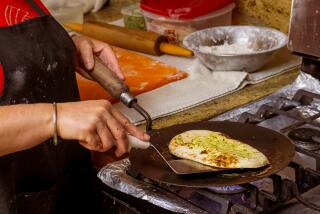New Gas-Powered Tandoor Oven for U.S. Kitchens
- Share via
An Indian restaurant without a tandoor oven is like a Mexican restaurant without a tortilla. At least, that’s the way it is in the United States, where tandoori chicken, lamb tikka , seekh kebab and other grilled meats dominate virtually every menu.
Without a tandoor, it’s impossible to duplicate these succulent meats, or to make naan breads, which are slapped on the tandoor’s walls to puff and brown in what seems like seconds.
Home cooks attempting to copy these foods either give up in frustration or content themselves with a not-very-authentic simulation. Importing a clay tandoor from India is expensive, and although there are dealers here who can supply the ovens, installing, maintaining and stoking them seems the province of the professional.
But this may change, thanks to Surjit S. Kalsi, president of Dynamic Cooking Systems Inc. of Huntington Beach. Kalsi has introduced a stainless-steel, gas-powered tandoor that comes in two sizes: a commercial oven for restaurants and a small model for home use.
The large oven can accommodate 10 to 12 whole chickens and up to a dozen naans . The home version can hold at least five naans and 8 to 10 whole chicken legs. Shaped like an inverted cone, the domestic oven weighs approximately 50 pounds and stands 2 feet tall. It operates with a propane tank, thus making it portable, or it can be attached to a gas line. In about 15 minutes, the oven heats to full tandoor power: 900 degrees. At that temperature, a chicken leg will cook in 10 minutes or less, and a naan in a minute or so. The sides of the commercial oven remain cool to the touch when it is in use. The outer shell of the home model does heat up, but not enough to burn.
Kalsi compares the steel ovens to the clay tandoor in this fashion: “It’s like the difference between a bullock cart and an airplane. They both get you from point A to point B, but one is faster, easier and cleaner.”
But ask Sada Riva Rao, the chef and owner of Bombay Grill, if he’d use a steel tandoor and he emphatically says, “No, ma’am--you can’t control it. It burns the chicken and the bread.” And, he insists, the texture of naan baked in a non-clay tandoor isn’t as soft and smooth as it should be. (Rao tried using a metal tandoor in a San Francisco restaurant.)
Other purists insist that only a charcoal-fueled, clay tandoor can produce authentic tandoori flavor. Kalsi disagrees. “Charcoal does not impart flavor,” he says. “Flavor is imparted by juices dripping on the charcoal and producing smoke.” In his ovens, the juices drip onto lava rock and produce the requisite smoke.
Whereas the clay tandoor must be fueled constantly and cleaned of the resulting ashes, the lava rock in the steel ovens will last for a year. And the ovens are self-cleaning, requiring only an occasional wipe-down, Kalsi said. Unlike the clay tandoor, the steel ovens will not crack or flake.
Kalsi introduced the steel tandoors two years ago. Initially they met with resistance from the Indian community, but that is changing, he said. So far, he has sold about 200 of the commercial ovens, shipping some of them across the country, and 300 of the home size. The large oven retails for $1,600, the home size for $350.
Formerly vice president of engineering with an appliance manufacturing company, Kalsi launched the ovens as a back-yard project. He came up with the design, ordered the parts from outside and assembled them. Now Kalsi operates from a roomy factory, where he also produces cooktops, outdoor barbecues and commercial Korean barbecue units.
The tandoors are literally part of the family. The home model is named Surya and the restaurant model Swaneel, after Kalsi’s sons. Wife Kawaljit (Kali) lends a hand when Kalsi needs someone to demonstrate that naan breads will stick to the steel sides (traditionalists believe they will stick only to clay) or that chicken tikka (marinated chunks of chicken) can acquire true tandoor flavor in the steel oven.
Kalsi is from Jullundur in the Punjab, where tandoor cookery is a common pursuit, and his wife is from Lucknow, the capital of the state of Uttar Pradesh.
“We have not changed the concept. What we have done is use different material,” Kalsi said. “It’s old technology brought to a modern age.”
More to Read
Eat your way across L.A.
Get our weekly Tasting Notes newsletter for reviews, news and more.
You may occasionally receive promotional content from the Los Angeles Times.










